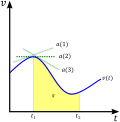Velocity
Velocity[edit]

Velocity is a vector quantity that refers to "the rate at which an object changes its position." It is a fundamental concept in physics and is essential in the study of kinematics. Unlike speed, which is a scalar quantity, velocity includes both the magnitude and the direction of motion.
Definition[edit]
Velocity is defined as the rate of change of displacement with respect to time. Mathematically, it is expressed as:
- \( \mathbf{v} = \frac{d\mathbf{s}}{dt} \)
where \( \mathbf{v} \) is the velocity, \( \mathbf{s} \) is the displacement, and \( t \) is time.
Types of Velocity[edit]
Constant Velocity[edit]
When an object moves with constant velocity, it covers equal displacements in equal intervals of time, regardless of how small these intervals may be. This implies that both the speed and direction of the object remain unchanged.
Variable Velocity[edit]
Variable velocity occurs when either the speed or the direction of the object changes. This can be further classified into:
- Uniformly Accelerated Motion: When the velocity of an object changes at a constant rate.
- Non-uniformly Accelerated Motion: When the velocity changes at a variable rate.
Velocity vs. Speed[edit]

While speed is a scalar quantity that only considers the magnitude of motion, velocity is a vector quantity that considers both magnitude and direction. For example, if a car travels at 60 km/h to the north, its speed is 60 km/h, but its velocity is 60 km/h north.
Mathematical Representation[edit]
Velocity can be represented graphically using a velocity-time graph. The slope of a velocity-time graph represents the acceleration of the object.
Applications[edit]
Velocity is crucial in various fields such as engineering, astronomy, and sports. In engineering, it helps in designing vehicles and predicting their performance. In astronomy, it is used to calculate the orbits of celestial bodies.
Related Concepts[edit]

See Also[edit]
References[edit]
- Halliday, D., Resnick, R., & Walker, J. (2013). Fundamentals of Physics. Wiley.
- Serway, R. A., & Jewett, J. W. (2018). Physics for Scientists and Engineers. Cengage Learning.
Related Pages[edit]

-
U.S. Navy sponsored Chevy Monte Carlo NASCAR at California Speedway
-
Velocity vs Time Graph
-
Kinematics Diagram
-
Radial and Tangential Components
Ad. Transform your life with W8MD's Budget GLP-1 injections from $75


W8MD offers a medical weight loss program to lose weight in Philadelphia. Our physician-supervised medical weight loss provides:
- Weight loss injections in NYC (generic and brand names):
- Zepbound / Mounjaro, Wegovy / Ozempic, Saxenda
- Most insurances accepted or discounted self-pay rates. We will obtain insurance prior authorizations if needed.
- Generic GLP1 weight loss injections from $75 for the starting dose.
- Also offer prescription weight loss medications including Phentermine, Qsymia, Diethylpropion, Contrave etc.
NYC weight loss doctor appointmentsNYC weight loss doctor appointments
Start your NYC weight loss journey today at our NYC medical weight loss and Philadelphia medical weight loss clinics.
- Call 718-946-5500 to lose weight in NYC or for medical weight loss in Philadelphia 215-676-2334.
- Tags:NYC medical weight loss, Philadelphia lose weight Zepbound NYC, Budget GLP1 weight loss injections, Wegovy Philadelphia, Wegovy NYC, Philadelphia medical weight loss, Brookly weight loss and Wegovy NYC
|
WikiMD's Wellness Encyclopedia |
| Let Food Be Thy Medicine Medicine Thy Food - Hippocrates |
Medical Disclaimer: WikiMD is not a substitute for professional medical advice. The information on WikiMD is provided as an information resource only, may be incorrect, outdated or misleading, and is not to be used or relied on for any diagnostic or treatment purposes. Please consult your health care provider before making any healthcare decisions or for guidance about a specific medical condition. WikiMD expressly disclaims responsibility, and shall have no liability, for any damages, loss, injury, or liability whatsoever suffered as a result of your reliance on the information contained in this site. By visiting this site you agree to the foregoing terms and conditions, which may from time to time be changed or supplemented by WikiMD. If you do not agree to the foregoing terms and conditions, you should not enter or use this site. See full disclaimer.
Credits:Most images are courtesy of Wikimedia commons, and templates, categories Wikipedia, licensed under CC BY SA or similar.
Translate this page: - East Asian
中文,
日本,
한국어,
South Asian
हिन्दी,
தமிழ்,
తెలుగు,
Urdu,
ಕನ್ನಡ,
Southeast Asian
Indonesian,
Vietnamese,
Thai,
မြန်မာဘာသာ,
বাংলা
European
español,
Deutsch,
français,
Greek,
português do Brasil,
polski,
română,
русский,
Nederlands,
norsk,
svenska,
suomi,
Italian
Middle Eastern & African
عربى,
Turkish,
Persian,
Hebrew,
Afrikaans,
isiZulu,
Kiswahili,
Other
Bulgarian,
Hungarian,
Czech,
Swedish,
മലയാളം,
मराठी,
ਪੰਜਾਬੀ,
ગુજરાતી,
Portuguese,
Ukrainian




